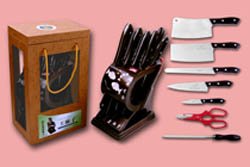 Many elderly Chinese might have vivid memories of Wang Mazi Scissors.
Many elderly Chinese might have vivid memories of Wang Mazi Scissors.
For centuries, the brand, which means "Pockmarked King," was a "must-have"
for many housewives.
Yet Beijing-based Wang Mazi Scissors Plant, the oldest factory in China, went
bust in 2004 after 353 years in operation.
Many explanations have been offered for its demise, such as intense
competition and mismanagement.
In the end, it all boils down to design, says Song Weizu, deputy
secretary-general of the China Industrial Design Association.
"For centuries, scissors made by Wang Mazi always came in the same shape and
boring black appearance," says Song.
It was not a lack of quality. The Wang Mazi Scissors Plant - which produced
swords for armies in the Qing Dynasty (1644-1911) - used superior steel, which
made its knives and scissors incredibly sharp.
"That was 'high-tech' in older times. But now design matters more," says
Song.
 In contrast to Wang Mazi's misfortune is the runaway success of Swiss
Army Brands, distributor of Swiss Army timepieces and Victorinox multi-purpose
tools, cutlery, travel gear and apparel.
In contrast to Wang Mazi's misfortune is the runaway success of Swiss
Army Brands, distributor of Swiss Army timepieces and Victorinox multi-purpose
tools, cutlery, travel gear and apparel.
Victorinox, whose first factory was set up two centuries ago, "has been
thriving largely on innovative designs, producing knives and multi-purpose tools
in various shapes and bold colours," says Song.
Underscoring Victorinox's innovations is its latest Swiss Army knife, which
skilfully combines a digital MP3 player, a two-inch blade, a pair of
mini-scissors and a nail file.
Perhaps companies like Wang Mazi were too old to adapt to the changing times,
but an increasing number of Chinese manufacturers, especially those in the
technology sector, are now quick to embrace the value of design.
In 2000, when Li Xiaozhong took over as president of Chinese home appliance
and consumer electronics maker Amoisonic, the Shanghai-listed firm was on the
brink of bankruptcy.
Li decided to buy a handset design from a South Korean firm with the little
cash that was left.
With it, Amoisonic, now renamed Amoi, launched its stylish A8 mobile phone
model, which was a hit in China.
"A single A8 handset model saved Amoi," says Pang Jun, an analyst with data
tracking firm GFK China.
 In 2002, the A8 was the best-selling model in China's high-end handset
market, with a 12 per cent share, according to GFK China. A Motorola model was
the second hottest with 9.6 per cent.
In 2002, the A8 was the best-selling model in China's high-end handset
market, with a 12 per cent share, according to GFK China. A Motorola model was
the second hottest with 9.6 per cent.
"Fashionable design and polyphonic features made the A8 a truly big success
story," says Pang.
The A8 model helped Amoi's profit margins in the mobile phone business,
chalking up a whopping 48 per cent.
The instant success of the A8 encouraged Amoi to make a big push into
research and development (R&D).
The firm now has a 1,200-strong R&D staff designing and developing a wide
range of products, from flat-panel TVs to computers and mobile phones.
"A great number of Chinese companies, especially those making end-user
products, are realizing that industrial design, which is a combination of art
and technology, has become an integral part of innovation," says Song.
(For more biz stories, please visit Industry Updates)